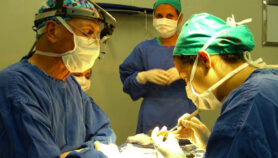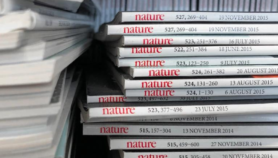By: Marc McIlhone
Send to a friend
The details you provide on this page will not be used to send unsolicited email, and will not be sold to a 3rd party. See privacy policy.
Brains Network editor Marc Mcilhone backs open sharing in the second article on how to support online science journalism in Africa.
The physical publishing of books, newspapers and magazines is as outdated as the concept of notebook journalism represented by Clark Kent — instead of Superman giving us our daily dose of news, we are now just as likely to receive it online from "citizen journalists" with no formal training.
The role of the journalist is changing, along with what is deemed journalism. The advent of online news aggregators and changing methods of consuming news have left traditional print media in a fight for survival.
SPEED READ
- Traditional print media are struggling because of web competition
- The challenge is to find a sustainable business model
- Publishers can make money from web advertising and phone apps rather than subscribers
So is traditional journalism, including science journalism, doomed, or is this an inevitable evolution in how information is processed and shared?
I’d argue for the latter. The challenge is for journalists and publishers to find a sustainable business model. A successful outcome could have a profound and positive effect on consumers of news, and science news in particular.
The immorality of ownership
In 1840, the French anarchist Pierre-Joseph Proudhon coined the phrase "Property is theft!". If scientific data or information is intellectual property, surely ownership and retention of it is theft from your fellow man or woman. How much worse a theft in developing countries, where access to that information can have such potential for positive change?
There is a moral obligation to share scientific data and information throughout the world — a view championed by the UN Educational, Scientific and Cultural Organization with its Open Access programme, which is particularly aimed at African and other developing countries that have far lower access rates than those in the West.
But philosophising aside, how can an honest science journalist make a living and carry on providing such a valuable service?
Let’s examine what other industries have tried.
Only recently have the music, publishing and film industries started to create sustainable business models. They realised — reluctantly — that, without change, piracy through file-sharing websites would send them the way of the dinosaurs.
The way to avoid this is by letting go of the physicality of their product. Digital versions of music singles are now sold through media players such as iTunes and subscription sites such as Napster.
New technology allows consumers to carry innumerable titles on one tablet, or e-reader, and all these changes allow publishers to sell the same product in a different format over and over again to the consumer.
Most newspapers began to carry their content on websites years ago, using online advertising to gain revenue. Although many now charge an online subscription fee, this does not necessarily signal the failure of open sharing where science journalism is concerned.
Open-sharing science news aggregators can draw on many different funding streams, including private institutions, universities and other public bodies, NGOs and general donations.
Interlinked business
In the case of news and networking website AfricanBrains, for example, the site is part of The Brains Network and a wider business: our publications, which are free to access on a group of websites, generate income from web advertising, and all online activity increases exposure for our government-business summits.
Original content from staff, freelancers and anyone who wants to contribute is posted onto our site and shared via social media. Each viewing can make money for the site — a portion of which is then passed on to the author — through advertising deals, and the author is encouraged to help generate traffic to their article through their own social media networks.
In general, this generates less income for contributors than traditional methods of payment. But repeat contributors are also offered free access to our summits, which cost at least £1,500 (just under US$2300) to attend, and provide valuable networking opportunities.
In principle, I see no reason why other publishers can’t follow this model. But it relies on establishing an online presence. Exposure can be achieved through news aggregation using RSS feeds, blogs and contributors.
For example, the Huffington Post, which was bought by AOL for US$315 million in 2011, started small. Through advertising revenues, it managed to start paying its bloggers and start up neighbourhood news site Patch.com, which now employs full-time journalists and pays freelancers US$50 a contribution.
It should be noted that poorly credited news aggregation contributes to poor wages for journalists and the demise of traditional publishing models — but only if the market allows it. The industry is in transition. Just as the Huffington Post has done, journalists, aggregators and publishers need to make adjustments.
Quality journalism, just like cream, will rise to the top. It will have to be supported by new publishing models and allow for things like aggregation.
New partnerships
To generate income, publishing houses should also look to new technologies such as tablets, smartphones and apps, as well as to partnerships.
Last month, computer firm Objectiva Software Solutions released an interactive, beautiful iPad app to display books produced by China’s largest medical publisher with a huge range of interactive features. Through a partnership and new technology, a new medium has been created to generate income by selling the app to the end user, with profits shared between software developer, publisher and content generator — potentially a science journalist.
With science and technology advancing at an ever-more impressive rate, the challenge is on for science journalism to evolve in a similar manner.
Sadly there are no excuses in the digital age. It is not only publishers who are in control of science journalism’s destiny. Journalists in this field also need to turn up prepared: they need to look at how to increase their options, whether by joining the university lecture circuit, self-publicising or even self-publishing.
These changing times should be seen as an opportunity to seize, not an obstacle.
Marc Mcilhone is editor of The Brains Network at AfricanBrains based in London, United Kingdom. He can be contacted at [email protected].
Related article:
A culture of plagiarism is harming Africa’s journalists













